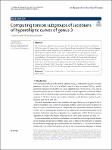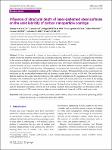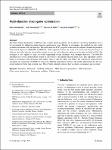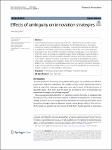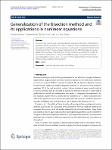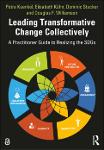Search
Author
- Osman, Ahmed I. (5)
- Daqing, Ma (3)
- Jorgensen, Ed (3)
- Li, Yan (3)
- next >
Subject
- kinh tế (26)
- Economics (12)
- programming (10)
- XRD (10)
- next >
Date issued
- 2020 - 2025 (2128)
- 2010 - 2019 (129)
- 2000 - 2009 (9)
- 1999 - 1999 (1)
Has File(s)
Search Results
We introduce an algorithm to compute the structure of the rational torsion subgroup of the Jacobian of a hyperelliptic curve of genus 3 over the rationals. We apply a Magma implementation of our algorithm to a database of curves with low discriminant due to Sutherland as well as a list of curves with small coefficients. In the process, we find several torsion structures not previously described in the literature. The algorithm is a generalisation of an algorithm for genus 2 due to Stoll, which we extend to abelian varieties satisfying certain conditions. |
Carbon nanoparticle coatings on laser-patterned stainless-steel surfaces present a solid lubrication system where the pattern’s recessions act as lubricant-retaining reservoirs. This study investigates the influence of the structural depth of line patterns coated with multi-walled carbon nanotubes (CNTs) and carbon onions (COs) on their respective potential to reduce friction and wear. Direct laser interference patterning (DLIP) with a pulse duration of 12 ps is used to create line patterns with three different structural depths at a periodicity of 3.5 µm on AISI 304 steel platelets. |
The maximum likelihood decoding problem (MLD) is known to be NP-hard and its complexity is strictly related to the security of some post-quantum cryptosystems, that is, the so-called code-based primitives. Analogously, the multivariate quadratic system problem (MQ) is NP-hard and its complexity is necessary for the security of the so-called multivariate-based primitives. In this paper we present a closed formula for a polynomial-time reduction from any instance of MLD to an instance of MQ, and viceversa. We also show a polynomial-time isomorphism between MQ and MLD, thus demonstrating the direct link between the two post-quantum cryptographic families. |
It is well known that if a finite set A⊂Z tiles the integers by translations, then the translation set must be periodic, so that the tiling is equivalent to a factorization A⊕B=ZM of a finite cyclic group. We are interested in characterizing all finite sets A⊂Z that have this property. Coven and Meyerowitz (J Algebra 212:161–174, 1999) proposed conditions (T1), (T2) that are sufficient for A to tile, and necessary when the cardinality of A has at most two distinct prime factors. They also proved that (T1) holds for all finite tiles, regardless of size. |
The Chaos Game Optimization (CGO) has only recently gained popularity, but its effective searching capabilities have a lot of potential for addressing single-objective optimization issues. Despite its advantages, this method can only tackle problems formulated with one objective. The multi-objective CGO proposed in this study is utilized to handle the problems with several objectives (MOCGO). In MOCGO, Pareto-optimal solutions are stored in a fixed-sized external archive. In addition, the leader selection functionality needed to carry out multi-objective optimization has been included in CGO. The technique is also applied to eight real-world engineering design challenges with multiple objectives. The MOCGO algorithm uses several mathematical models in chaos theory and fractals inher... |
Technological innovations significantly influence individual firms and other innovations, such as financial innovations. The future of a firm depends on its innovation investment strategy. According to the literature, innovation investments are affected by ambiguity. This study examines how ambiguity affects the innovation strategies of managers. We show that the innovation strategies of ambiguity-averse managers differ from those of ambiguity-neutral managers. Unlike ambiguity-neutral managers, ambiguity-averse managers consider a broader variety of innovation strategies for a wider range of future innovation arrival times. |
Understanding the impact of collective social phenomena in epidemic dynamics is a crucial task to effectively contain the disease spread. In this work, we build a mathematical description for assessing the interplay between opinion polarization and the evolution of a disease. The proposed kinetic approach describes the evolution of aggregate quantities characterizing the agents belonging to epidemiologically relevant states and will show that the spread of the disease is closely related to consensus dynamics distribution in which opinion polarization may emerge. |
The aim of the current work is to generalize the well-known bisection method using quantum calculus approach. The results for different values of quantum parameter q are analyzed, and the rate of convergence for each q∈(0,1) is also determined. Some physical problems in engineering are resolved using the QBM technique for various values of the quantum parameter q up to three iterations to examine the validity of the method. Furthermore, it is proven that QBM is always convergent and that for each interval there exists q∈(0,1)
for which the first approximation of root coincides with the precise solution of the problem. |
This book directly helps decision-makers and change agents in companies, NGOs, and government bodies become more proficient in transformative, collaborative change in realizing the SDGs. This practitioner’s handbook translates a systemic – and enlivening – approach to collaboration into day-to-day work and management. It connects the emerging practice of multi-stakeholder collaboration to easily understandable models, tools, and cases. Numerous, concrete cases not only bring this methodology to life, but also help identify the challenges and avoid common mistakes. The book can be used as a guide to apply a breakthrough approach for navigating the complexity of stakeholder systems, designing results-oriented process architectures, ensuring the success of cross-sector change initiativ... |
We propose an efficient mesh adaptive method for the numerical solution of time-dependent partial differential equations considered in the fixed space-time cylinder Ω×(0,T). We employ the space-time discontinuous Galerkin method which enables us to use different meshes at different time levels in a natural way. The mesh adaptive algorithm is based on control of the interpolation error in the L∞(0,T;Lq(Ω))-norm. |

